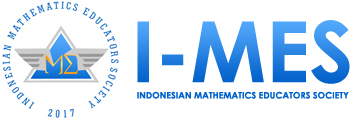MATHEMATICAL AESTHETICS OF JEPARA'S CARVING
Abstract
Jepara's carving is a work of art with a mathematical concept of aesthetic value. Mathematical aesthetics refers to the relationship between mathematics and aesthetic values, namely the beauty of mathematics integrated with the art of Jepara's carving. The qualitative descriptive method is used to describe aesthetics and mathematical concepts in Jepara's carving and the relationship between the two focuses of the study. Data were collected using semi-structured interviews, non-participatory observation, and documentation. The research subjects consisted of two informants: art and culture teachers and Jepara's carving artisans. The data were analyzed using the Miles and Huberman model, which consisted of the following stages: data reduction, data presentation, and conclusion drawing. The results showed that: (1) Jepara's carving has aesthetic value, seen from the fulfillment of aesthetic elements, namely: unity, complexity, sincerity, and balance; (2) the process of making Jepara's carving applies the mathematical concept of comparison, which plays an essential role in making Jepara's carving patterns; and (3) there is a collaboration between the application of mathematical concepts and aesthetic theory in creating the term mathematical aesthetics in Jepara's carving which refers to geometric aesthetics, wherein this Jepara's carving motif there is a regularity of patterns dominated by  .
Full Text:
PDFReferences
Amir, Z. (2015). Mengungkap Seni Bermatematika dalam Pembelajaran. Suska Journal of Mathematics Education, 1(1), 60 – 76. Doi:10.24014/sjme.v1i1.1364
Creswell, J.w., Pancasari, R.K. (Trans.), & Fawaid A. (2016). Research Design: Pendekatan Kualitatif, Kuantitatif, dan Mixed (4th ed). Yogyakarta: Pustaka Pelajar.
D'Ambrosio, U. (1985). Ethnomathematics and its Place in the History and Pedagogy of
Mathematics. For the learning of Mathematics, 5(1), 44-48. Retrieved from
https://www.jstor.org/stable/ 40247876
Departemen Pendidikan Nasional. (2008). Kamus Besar Bahasa Indonesia. Jakarta: Pusat Bahasa.
Djelantik, A.M. (2004). Estetika Sebuah Pengantar. Bandung: Masyarakat Seni Pertunjukan Indonesia.
Fahrurrozi & Hamdi, S. (2017). Metode Pembelajaran Matematika. Universitas Hamzanwadi Press.
Gerdes, P. (1994). Reflection on Ethnomathematics. For the Learning of Mathematics, 14(2),
-21. Retrieved from https://flmjournal.org/Articles/1CC7C4A1B63D66ADF10C6D5AE98E58. pdf
Gie, T.L. (1976). Garis Besar Estetika (Filsafat Keindahan). Yogyakarta: Pusat Belajar Ilmu Berguna.
Gustami, S.P. (2000). Seni Kerajinan Mebel Ukir Jepara: Kajian Estetik Melalui Pendekatan Multidisiplin. Yogyakarta: Kanisius.
Mochsen, M. (2005). Tipologi Geometri: Telaah Beberapa Karya Frank L. Wright dan Frank O. Gehry (Bangunan Rumah Tinggal sebagai Objek Telaah). Jurnal RONA Arsitektur Fakultas Teknik Universitas Hasanudin, 2(1), 69 – 83. Retrieved from https://ronajurnal.wordpress.com/
Muhtadi, D., Sukirwan, Warsito, & Prahmana, R.C.I. (2017). Sundanese Ethnomathematics:
Mathematical Activities in Estimating, Measuring, and Making Patterns. Journal on
Mathematics Education, 8(2), 185-198. Doi:10.22342/jme.8.2.4055.185-198
Nangoy, O.M. & Sofiana Y. (2013). Sejarah Mebel Ukir Jepara. Jurnal Humaniora, 4(1), 257-264. Doi:10.21512/humaniora.v4i1.3436
Nasution, A.H. (1980). Landasan Matematika. Jakarta: Bhratara Karya Aksara.
Reys, et al. (1984). Dasar – Dasar Matematika. Jakarta: Bumi Aksara.
Soepratno, B.A. (2004). Ornamen Ukir Kayu Tradisional Jawa 1: Keterampilan Menggambar dan Mengukir Kayu. Semarang: Effhar dan Dahara Prize.
Steadman, J. (1983). Architecture Morphology: An Introduction to the Geometry of Building Plans. London: Pion Limited.
Sudirman, Rosdyadi, & Lestari, W.D. (2017). Penggunaan Etnomatematika pada Karya Seni Batik Indramayu dalam Pembelajaran Geometri Transformasi. Jurnal Pedagogy, 2(1), 74 – 85. Doi:10.30605/pedagogy.v2i1.662
Sugiyono. (2019). Metode Penelitian Kuantitatif, Kualitatif dan R & D (2nd ed). Bandung: Alfabeta.
Umar, M. (2009). Mesopotamia dan Mesir Kuno: Awal Peradaban Dunia. El-Harakah, 11(3), 198 – 215. Doi:10.18860/el.v0i0.434
Utami, R.N.F., Muhtadi, D., Ratnaningsih, N., Sukirwan, & Hamid, H. (2020). Etnomatematika: Eksplorasi Candi Borobudur. Jurnal Penelitian Pendidikan dan Pengajaran Matematika, 6(1), 13 – 26. Doi:10.37058/jp3m.v6i1.1438
Utami, R.N.F., Hermanto, R., Muhtadi, D., & Sukirwan. (2021). Etnomatematika: Eksplorasi Seni Ukir Jepara. Jurnal Penelitian Pendidikan dan Pengajaran Matematika, 7(1), 23 – 38. Doi: 10.37058/jp3m.v7i1.2551
Zainul, R. (2018). Desain Geometri Sel PV. Solok: Penerbit dan Percetakan CV Berkah Prima.
DOI: https://doi.org/10.37058/jarme.v5i1.5692
Refbacks
- There are currently no refbacks.

This work is licensed under a Creative Commons Attribution-ShareAlike 4.0 International License.
Jurnal Penelitian Otentik Pendidikan Matematika (JARME)
Program Studi Pendidikan Matematika Universitas Siliwangi
Jl. Siliwangi no. 24 Kota Tasikmalaya - 46115
email: jarme@unsil.ac.id
e-ISSN: 2655-7762
Dilisensikan di bawah Lisensi Creative Commons Attribution 4.0 International
StatCounter: Detail
Diindeks oleh :


.jpg)
.jpg)



